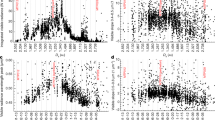Abstract
THE gravitational attractions of the Sun and planets do not account completely for the orbital motions of short-period comets, which tend to return to perihelia with some delay or advance as compared with the gravitational solution. Debate over the physical cause of these 'nongravitational effects' has continued from the time they were discovered, in the early nineteenth century. Uncertainty over their origin has made prediction of these effects for any particular comet impossible. To clarify the roles of the radial and transverse components of the nongravitational force, and thus to arrive at an accurate picture with predictive power, we have used observational data on gas production rates from comets as a diagnostic of the force. The shapes of the production curves, based mostly on visual light curves, correlate very well with the nongravitational delays or advances of a number of comets, and we have used this correlation to predict a substantial advance of the recent perihelion passage of comet P/Brorsen–Metcalf, as verified by observations.
This is a preview of subscription content, access via your institution
Access options
Subscribe to this journal
Receive 51 print issues and online access
$199.00 per year
only $3.90 per issue
Buy this article
- Purchase on Springer Link
- Instant access to full article PDF
Prices may be subject to local taxes which are calculated during checkout
Similar content being viewed by others
References
Bessel, F. W. Astr. Nachr. 13, 345–350 (1836).
Whipple, F. L. Astrophys. J. 111, 375–394 (1950).
Marsden, B. G., Sekanina, Z. & Yeomans, D. K. Astr. J. 78, 211–225 (1973).
Rickman, H. in Comet Nucleus Sample Return Mission ESA SP-249, 195–205 (European Space Agency, Noordwijk, 1986).
Yeomans, D. K. & Chodas, P. W. Astr. J. 98, 1083–1093 (1989).
Festou, M. C. in Asteroids Comets Meteors II (eds Lagerkvist, C.-l., Lindblad, B. A., Lundstedt, H. & Rickman, H.) 299–303 (Uppsala University, Reprocentralen HSC, 1986).
Kresák, L. & Kresáková, M. in The Diversity and Similarity of Comets ESA SP-278, 37–42 (European Space Agency, Noordwijk, 1987).
Marsden, B. G. Catalogue of Cometary Orbits 5th edn (IAU Central Bureau for Astronomical Telegrams. Cambridge, Massachusetts, 1986).
Rickman, H., Kamél, L., Festou, M. C. & Froeschlé, CI. in The Diversity and Similarity of Comets ESA SP-278, 471–481 (European Space Agency, Noordwijk, 1987).
Schleicher D.G., Osip, O. J. & Millis, R. L. IAU Circ. No. 4810 (1989).
Festou, M. C., Rickman, H. & Kamél, L. IAU Circ. No. 4804 (1989).
Helin, E. F. IAU Circ. No. 4804 (1989).
Author information
Authors and Affiliations
Rights and permissions
About this article
Cite this article
Festou, M., Rickman, H. & Kamél, L. Using comet light-curve asymmetries to predict comet returns. Nature 345, 235–238 (1990). https://doi.org/10.1038/345235a0
Received:
Accepted:
Issue Date:
DOI: https://doi.org/10.1038/345235a0
This article is cited by
-
Comets
The Astronomy and Astrophysics Review (1993)
Comments
By submitting a comment you agree to abide by our Terms and Community Guidelines. If you find something abusive or that does not comply with our terms or guidelines please flag it as inappropriate.



